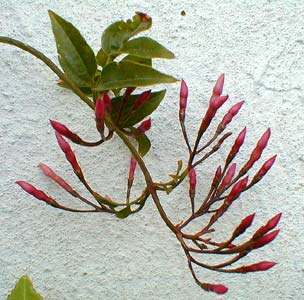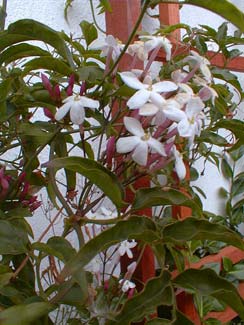
Pink Jasmine; or,
Chinese Evergreen Jasmine
"The lattice of thy casement twines
With jasmine vines, with jasmine vines;
The stars, like jasmine blossoms, lie
About the glimmering sky.
No jasmine tress
Can so caress
Like thy white arms' soft loveliness."
-Madison Julius Cawein
(1865-1914)
(1865-1914)
Pink Jasmine (Jasminum polyanthum), native to western & southern China, is a fast-climbing evergreen vine that can very easily cover twenty feet of fence, wall, or pergola. It can also be kept severely pruned to function as a small trellised shrub of around six feet height, or it can be grown as a groundcover or in containers.
Here on Puget Sound it will suffer some winter damage in exposed, windy locations. But ours is climbing in full morning to noon sun, on a large trellis right against the house, where residual warmth from walls & window, & sheltering eaves above, keep it partially evergreen.
 Though called "Pink" it is only the buds that are bright pink. When opened the star-shaped flowers are pure white.
Though called "Pink" it is only the buds that are bright pink. When opened the star-shaped flowers are pure white.It is alternatively called Pink Winter Jasmine (distinct from yellow-flowering J. nudilflorumalso called Winter Jasmine), because Pink Jasmine begins blooming by February, sometimes by January, & continues to bloom the entirety of spring & much of the summer. In our garden, however, with morning sun only, it doesn't bloom until May, & continues through summer, a few blooms lingering into autumn. In more southern & warmer zones than ours, it stops blooming earlier in the year, as it dislikes very hot summers.
The flowers have splendid scent which fills our garden from one end to the other with its sweet redolence for months on end.
If grown indoors or in heated greenhouses, it may have to be kept in a moveable container so that it can be taken outside to experience a moderate chill in late autumn or early winter, for if it does not detect the seasons, it will not set buds.
It likes rich, moist, well draining soil, & as with the majority of vines that bloom through multiple seasons, it benefits from liquid fertilizer fed to it once a month spring until the start of autumn; but it will also do quite nicely if fed only once, in late winter or early spring, with a slow-release granular fertilizer.
When it is through blooming, it will require a good solid sheering in order to again bloom well the following year. One mustn't wait until long after it is through blooming to prune it, or the following winter's end buds will already be setting.